The landing of a 250 Watt transmitter was to take place about a week after the invasion. Meanwhile it was hoped that some time would be available on the three operational transmitters that the army hoped to set up on D-Day. The first recording truck was not due to go ashore until a fortnight after D-Day.

The Midget Recorders
In order to make their reports, some correspondents were ferried back to transmission points set up near the south coast of England, from where voice pieces could be filed and discs played up to Broadcasting House. The busiest of these was near Fareham where facilities included a recording van.
These early arrangements meant that uncensored material was being brought across the channel, and that this was allowed is a measure of the military's trust in the BBC's War Reporting Unit.
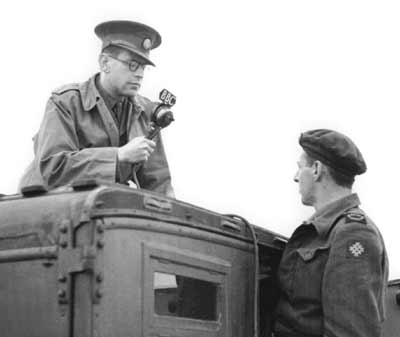
A BBC correspondent on top of a recording truck, watched
by a non-BBC correspondent.
The first of the BBC's transmitters to travel to France was a 250 watt MF and HF STC type HS1, call sign MCO (Mike - Charlie - Oboe). It was at first mounted in a Bedford truck which was forbidden to embark because the clearance of its chassis was too low. A week before D-Day it was installed in a more suitable 3-ton truck, together with aerial equipment, power generator, amplifiers, microphones, etc. Disembarking at Arromanches during the night of 17/18th June, it had to plunge into four feet of water, but within a few hours it was making test transmissions. A tent was used as a studio for the first dispatches, but the following day a studio was established in a tower room within a fourteenth century castle at Creully, near Bayeux. This was used by a constant procession of reporters - not just for the BBC but for American and Canadian networks, and for transmissions to Nazi occupied Europe. Later, MCO followed the Canadian Army along the coast, reaching Brussels on 12 October.
An open-air church service was broadcast from the Normandy beach-head, arranged by Frank Gillard. Mic cables were run back to the control room in the castle at Creully. An 'organ' was improvised by placing a mic beside a portable harmonium and feeding its output to an Army loudspeaker van, normally used to speak to the enemy across no-man's-land. During the transmission a censor sat in the control room, ready to cut the broadcast if necessary. General Montgomery read a lesson (he was a great supporter of broadcasting as a morale-booster) and the hymns and prayers were accompanied by the sound of (friendly) fighter aircraft, Creully's church bells and bird-song.
By the end of July a 5-kilowatt RCA HF transmitter had arrived and was installed at Le Marais, a few miles from Bayeux. It used the call-sign MCP. It later moved to Paris and was re-installed at Pontoise, where it stayed until February 1945 then being returned to England.
A modified 7½-kilowatt RCA HF transmitter (MCN) landed on 1 September, but was unable to keep up with the advancing army. It wasn't until September (probably the fifth) that it was on the air, after modifications were made in Brussels. Together with MCO it followed the 1945 Spring Advance, crossing the Rhine on 23 March 1945. Following the signing of the surrender on 4 May both transmitters were returned to the UK.
A second 7½-kilowatt transmitter arrived in Brussels in February 1945 and took over the call sign MCP. It followed the 12th US Army Group through the Ardennes offensive, and on to Berlin. It was later used to cover the Nuremberg Trials and then handed over to the British Forces Network.
Hundreds of live broadcasts were handled by these transmitters, and thousands of recorded dispatches were sent. Reception in London was often good enough for use on air, though backup recordings were sent back using couriers. The transmitters' signals were picked up by the listening station at Tatsfield and fed by line to Broadcasting House. In BH recording channels were always open, day and night, to record these pieces. Dispatches were also recorded by the Telediphone unit. The Telediphone machine recorded onto a wax cylinder, which could be played back to a typist. The resulting scripts were then circulated to all news departments. In the early days they would be submitted to censors in London. Later the censors travelled with the correspondents and material was reviewed at source.
In order to provide two-way communication with the correspondents and engineers in the field, a short-wave transmitter was installed in Broadcasting House.
Roy Hayward remembers the BH control room operation.
BH Control Room
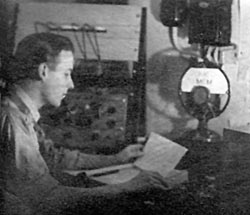
Roy in the Control Room shack.
Messages from WRU would be taken by hand by secretaries down to these operators and were then transmitted in plain language in morse code to the appropriate truck. They replied in voice on their studio microphone. The Balcony transmitter had the call-sign "Mike Charlie Mike" and operated on four selectable frequencies MCM1, MCM2, MCM3, MCM4, according to the reception conditions on the other side of the English Channel. At the other end, the trucks had a similar set-up with call signs; Mike Charlie Nan, Mike Charlie Oboe, Mike Charlie Peter.
The American networks soon had their own shortwave transmitters JESQ (Jig Easy Sugar Queen) JEEP (Jig Easy Easy Peter). Some of the NBC and ABC reporters were very good at morse and often replied to our morse coded communication themselves without the help of an engineer. I suppose the most frequent message to these American reporters was to inform them of the exact time their report was scheduled into their networks in the US. This came from the American staff (Ed Murrow, Walter Cronkite, et al) on the second floor and was more often or not to confirm a live transmission from the mobile in France direct, into their network at precisely 23hrs. 03min. 30secs and to run no more than 3min. 45secs. From LCR it was "double endered" into an outgoings line called RT, which was a high quality trans-Atlantic circuit. Most of the time, Tatsfield would be able to get a good, broadcastable signal but there were times when the signal was weak or distorted or obliterated by atmospheric conditions.
At these times it was sometimes possible to get a reasonable reception from our own aerial on the roof of BH down to the Hallicrafters in the shack on the balcony and down to the control room and save the day. Of course all our transmissions were being scrupulously monitored by the Home Office personal or the Ministry of Information censors as were we operating openly in plain language and after all, there was a war on.
On one occasion I came on evening shift to find the shack had been closed down all day and within half an hour it was allowed to continue and I had a massive number of memos and messages to send off. One of the recording engineers was A. E. Windsor, who had been on a short visit back to base in London and was returning the following day. Unfortunately, my colleague on the shift before me had sent out a message to MCO3 to the effect that "Winnie was coming out tomorrow so look out for him". What none of us knew was that Winston Churchill himself was, on the following day, also going to be in the recording trucks' area to visit the troops! Within moments there was a dark limousine at the front door and three dark-suited gentlemen descended upon the operator in the shack, closed it down and took the poor, bewildered chap up to, I think, the D.G.'s Office and demanded to know who he was and who his grandmother was, etc, etc!! Of course it got cleared up in the end but I am sure the poor chap met more members of the top Brass of the BBC that afternoon than any of us ever did!
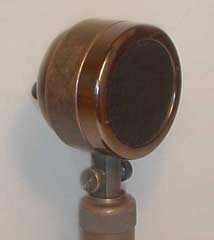
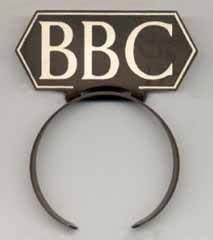
The microphones being used by the correspondents are STC 4017Cs, fitted onto a stick mic handle and with a clip-on BBC logo.
These two pictures, and that of the midget recorder,
courtesy Chris Owen.
The programme War Report was first broadcast in the Home Service on D-Day - 6th June 1944. It achieved a daily audience of ten to fifteen million at home. Those listeners knew that what they were hearing was also heard by their loved ones in the services abroad, and by French, Belgians or Dutchmen whose lands were still under German occupation. War Report was much less formal than the 9 o'clock news, which it followed. It broadcast the sounds of battle, recorded in the field, the voices of the fighting men and the reports of the correspondents who were witnessing events at first hand.
Many of the dispatches used in War Report were also broadcast in Radio News Reel, in the Overseas Service. On D-Day, in the United States, 725 radio stations carried War Report.
The production office was in the former artists' Green Room. The working day began at 0930 with a review of scripts of dispatches recorded overnight. During the afternoon the actual recordings were reviewed, and edited if necessary. This was done by copying from disc to disc. Complex editing would involve three generations - the required passages of the original disc being dubbed to separate discs which were then played consecutively and re-recorded.
Guests would also be arriving at BH. A returning soldier with a tale to tell would be invited in, pilots might be brought from remote stations to tell their tales. Their stories were scripted and the scripts were submitted to the censors before the pieces could be recorded. The transmission came from an area known as 'L1 and mixer', which consisted of a studio, and recording room and, between them, a cubicle.
Under normal circumstances, programmes like War Report would be carefully rehearsed. By the end of the war there had been 235 editions of the programme - and only once was an attempt made to rehearse! The final transmission was on 5th May 1945. The programme was off the air from 4th February 1945 until the crossing of the Rhine on 23rd-24th March.
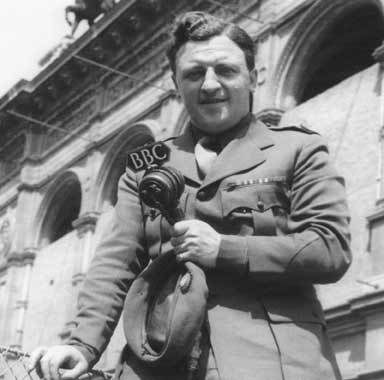
He was the first radio reporter to reach the concentration camp at Belsen, and the first to enter Berlin.
Reg Pidsley, who took many of the monochrome photos on these pages, didn't immediately return to Britain after the war. He continued to photograph aspects of the Berlin scene until mid-1946.

